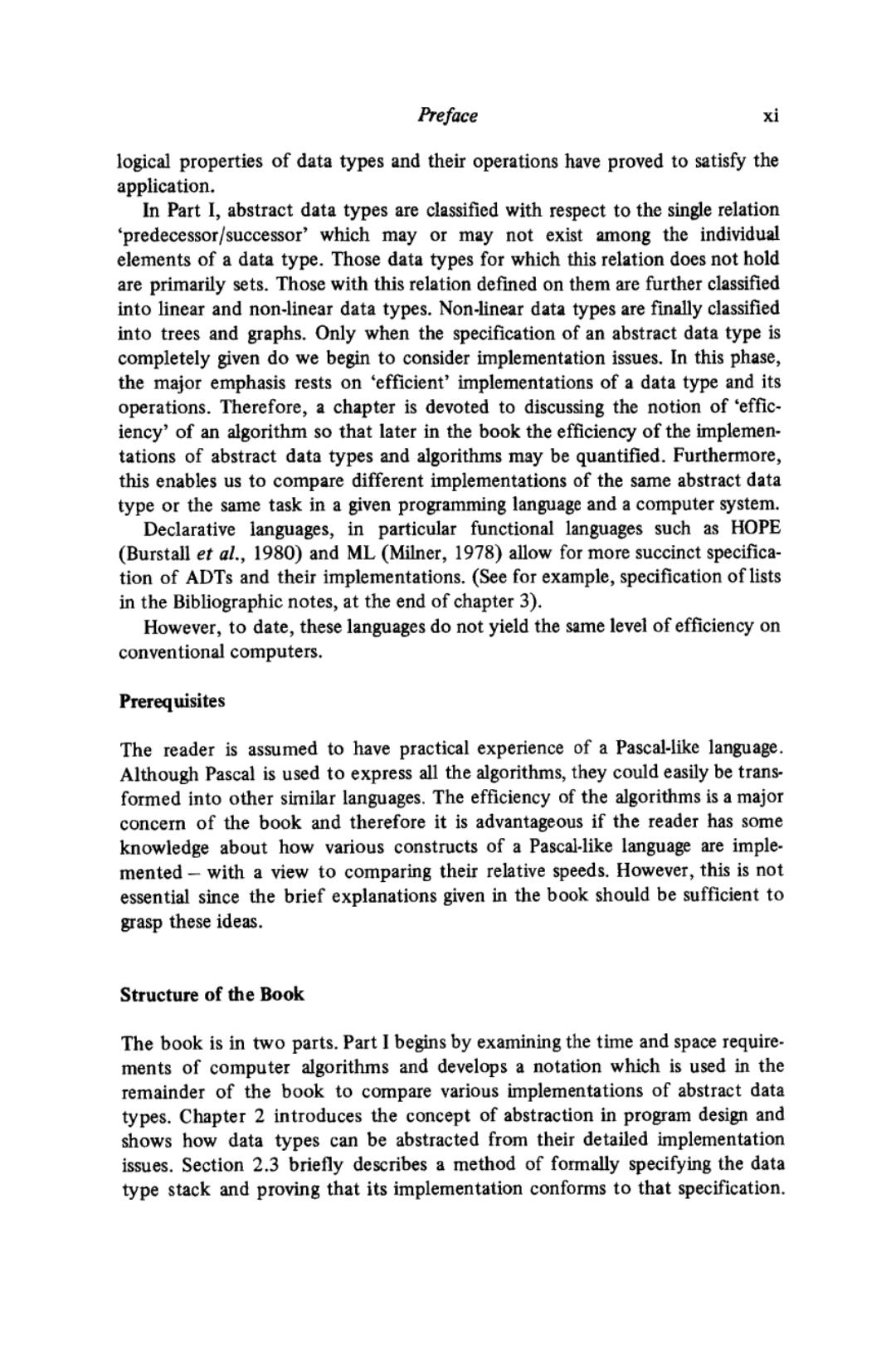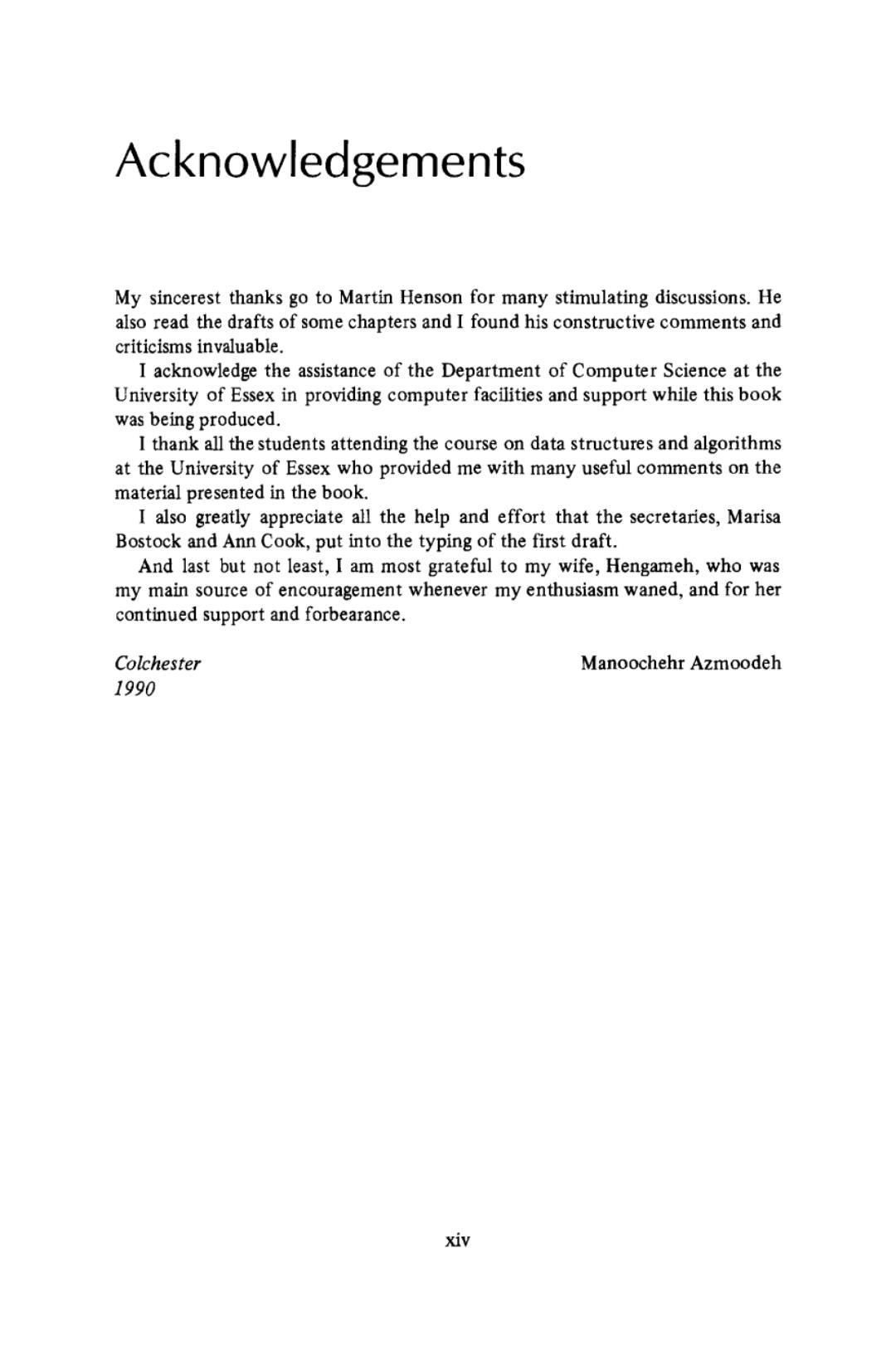
Preface xi logical properties of data types and their operations have proved to satisfy the application. In Part I,abstract data types are classified with respect to the single relation 'predecessor/successor'which may or may not exist among the individual elements of a data type.Those data types for which this relation does not hold are primarily sets.Those with this relation defined on them are further classified into linear and non-linear data types.Non-linear data types are finally classified into trees and graphs.Only when the specification of an abstract data type is completely given do we begin to consider implementation issues.In this phase, the major emphasis rests on 'efficient'implementations of a data type and its operations.Therefore,a chapter is devoted to discussing the notion of 'effic- iency'of an algorithm so that later in the book the efficiency of the implemen- tations of abstract data types and algorithms may be quantified.Furthermore, this enables us to compare different implementations of the same abstract data type or the same task in a given programming language and a computer system. Declarative languages,in particular functional languages such as HOPE (Burstall et al.,1980)and ML (Milner,1978)allow for more succinct specifica- tion of ADTs and their implementations.(See for example,specification of lists in the Bibliographic notes,at the end of chapter 3). However,to date,these languages do not yield the same level of efficiency on conventional computers. Prerequisites The reader is assumed to have practical experience of a Pascal-like language. Although Pascal is used to express all the algorithms,they could easily be trans- formed into other similar languages.The efficiency of the algorithms is a major concern of the book and therefore it is advantageous if the reader has some knowledge about how various constructs of a Pascal-like language are imple- mented-with a view to comparing their relative speeds.However,this is not essential since the brief explanations given in the book should be sufficient to grasp these ideas. Structure of the Book The book is in two parts.Part I begins by examining the time and space require- ments of computer algorithms and develops a notation which is used in the remainder of the book to compare various implementations of abstract data types.Chapter 2 introduces the concept of abstraction in program design and shows how data types can be abstracted from their detailed implementation issues.Section 2.3 briefly describes a method of formally specifying the data type stack and proving that its implementation conforms to that specification

xii Preface The remainder of the book relies on informal specifications and proofs.This section and the bibliographic notes at the end of chapter 3 are intended as a guide for more interested readers,should they wish to explore the topic more rigorously;therefore it may be skipped in its entirety or on the first reading. Chapters 3 to 7 then discuss a variety of abstract data types including stacks, queues,lists,sets,trees,relations and graphs.Each abstract data type is defined as a mathematical model with a number of operations defined on that model. The operations are given as a set of Pascal procedures and functions.Various implementation strategies of these data types are discussed in terms of Pascal constructs.Examples of applications of these abstract data types are also given. Part II further describes many algorithms and common techniques for deve. loping efficient algorithms using abstract data types.Programming paradigms such as divide and conquer,dynamic programming,graph searching,tabulation techniques and randomised algorithms,are discussed.Chapter 9 develops a divide and conquer algorithm for the sorting problem and it is shown how implemen- tation considerations are delayed until the final stage of program design.Finally, it is emphasised that these algorithm design techniques are not universal tools for producing efficient algorithms for all problems.In particular,chapter 12 briefly discusses the class of 'hard'problems for which most algorithms are not very efficient.A few techniques are described,such as how to handle such inherently difficult problems. Exercises and Assignments Computer programming can only really be learnt through experience.Merely reading about it is no substitute for first-hand practical experience.Therefore, to reinforce the ideas,exercises are included at the end of each chapter.These are usually simple and can be tackled after the content of the chapter is well understood.Some involve verifying algorithms by checking them manually on paper,while others require the writing of programs or fragments of programs. Guidance on the solutions of selected exercises is provided at the end of the book.Since the emphasis of the book is on the efficient implementation of various abstract data types and the comparison of algorithms,a few practical assignments are also included among the exercises.These take the form of designing,writing and testing actual programs.A few guidelines on the design of data types and algorithms for these assignments are given in the solutions to exercises. Bibliographic Notes and Further Reading No book of this size can deal comprehensively with abstract data types,data structures,algorithm design and the theory and practice of programming with data.However,the material presented here should provide an introduction to the practical issues of abstract data type and algorithm design.For motivated

Preface xⅲ readers,each chapter concludes with a brief list of related literature and some comments on it.Many of the references are articles published in computer journals;these journals and their abbreviations are given below. ACM:Association for Computing Machinery ACM Computing Surveys ACM TODS:ACM Transactions on Databases Acta Informatica BIT:Behandlings Informations Tidskrift-Denmark CACM:Communication of the ACM Computer Journal-British Computer Society Journal of the ACM SIAM:Social and Industrial Applied Mathematics SIAM Journal of Computing Software Practice and Experience References Aho,A.V.,Hopcroft,J.E.and Ullman,J.D.(1974).The Design and Analysis of Computer Algorithms,Addison-Wesley,Reading,Massachusetts. Aho,A.V.,Hopcroft,J.E.and Ullman,J.D.(1983).Data Structures and Algorithms,Addison-Wesley,Reading,Massachusetts. Baron,R.J.and Shapiro,L.G.(1980).Data Structures and their Implementa- tions,PWS Publications,Boston,Massachusetts. Burstall,R.M.,MacQueen,D.B.and Sannella,D.T.(1980).'Hope:an experi- mental applicative language',in Proceedings of 1980 Lisp Conference,Stanford, California,pp.136-143. Gotlieb,C.C.and Gotlieb,L.R.(1978).Data Types and Data Structures, Prentice-Hall,Englewood Cliffs,New Jersey. Knuth,D.E.(1973).The Art of Computer Programming.Volume 1:Funda- mental Algorithms,2nd edition,Addison-Wesley,Reading,Massachusetts. Korsh,J.F.(1986).Data Structures,Algorithms and Program Style,PWS Computer Science,Boston,Massachusetts. Martin,J.J.(1986).Data Types and Data Structures,Prentice-Hall,Englewood Cliffs,New Jersey. Milner,R.(1978).'A theory of type polymorphism in programming',Journal of Computer and Systems Science,Vol.17,No.3 pp.348-375. Reingold,E.and Hansen,W.(1983).Data Structures,Little,Brown,Boston, Massachusetts. Stubbs,D.and Webre,N.(1985).Data Structures with Abstract Data Types and Pascal,Brooks/Cole Publishing,Monterey,California. Wirth,N.(1976).Algorithms Data Structures Programs,Prentice-Hall (1986). Englewood Cliffs,New Jersey. Wirth,N.(1986).Algorithms Data Structures,Prentice-Hall,Englewood Cliffs, New Jersey

Acknowledgements My sincerest thanks go to Martin Henson for many stimulating discussions.He also read the drafts of some chapters and I found his constructive comments and criticisms invaluable. I acknowledge the assistance of the Department of Computer Science at the University of Essex in providing computer facilities and support while this book was being produced. I thank all the students attending the course on data structures and algorithms at the University of Essex who provided me with many useful comments on the material presented in the book. I also greatly appreciate all the help and effort that the secretaries,Marisa Bostock and Ann Cook,put into the typing of the first draft. And last but not least,I am most grateful to my wife,Hengameh,who was my main source of encouragement whenever my enthusiasm waned,and for her continued support and forbearance. Colchester Manoochehr Azmoodeh 1990 xiv

Preliminaries and Notation The only prerequisites for reading this book are practical experience in program- ming in a Pascal-like language and a sound understanding of general programming concepts together with a good grasp of Pascal-like data types (that is,reals, integers,characters,arrays and records).However,the analysis of many data structures and algorithms in the book requires a minimal understanding of such basic mathematical concepts as sets,functions etc.For the purposes of reference and also to introduce the notation used,a brief survey of these concepts is given below.A discussion of the idiosyncrasies of Pascal syntax,as used in the book, then follows. Mathematical Backgrounds Sets A set is a collection of objects called members.The members of a set are usually of the same type.For example S:A set of colours =fred,blue,yellow,white} S2:The set of negative numbers={x lx is an integer and x<0} S3:An empty set={). The and 'are used to represent sets;in S2,x is a variable and''should read as 'such that'.Therefore set S2 should read as 'the set of all values of x such that x is an integer andx is less than 0'.'A is a member of a set S'and 'B is not a member of a set S'are denoted as:A ES and BS.Thus red∈S1 brown年S1 -15∈S2 3398年S2 Members of sets are not ordered.Therefore fred,blue}={blue,red}.The number of members in a set S is called its cardinality and is denoted by ISI.Therefore, |S11=4,IS3l=0. Subsets Set S is a subset of S'if every member of S is also a member of S'.This is denoted as SC S'.We denote'S is not a subset of S''as S S'. XV